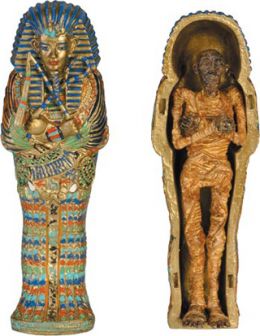The entire world’s fascination with mummies began the day Howard Carter unearthed Tutenkhamen’s tomb. The Egyptian mummy that had gripped the imagination of historians worldwide, led to the beginning of an endless search for answers and even more mummies.
Egyptian Mummies Process
Mummies, although not unique to the Ancient Egyptians, were an important part of their culture. Death and the afterlife was a major aspect of their culture as well.

The ancient Egyptians, had a God dedicated to death, Anubis, the god of death, surgeon, and healers. He was linked to the process of mummification. Earlier, he was invoked while the Pharaoh was being buried.The head priest donned the mask of Anubis while conducting the mummification. This was done due to their belief that Anubis will direct them properly during the process. Although, like other gods of Ancient Egyptians, he was attributed more than one power.
In all their writings, art, religion and rituals, there are numerous references to death and afterlife. Their biggest contribution to architecture, the Pyramid, was constructed to safeguard the dead.
The Ancient Egyptians were highly superstitious about the afterlife of the deceased, it was a part of their psyche, religious and daily life. Therefore, their practice of embalming the dead stems from this fact. They were not satisfied with mere burial; it had to be done precisely with all the rituals, more in the case of Pharaohs.
 The procedure is long, about 70 days, and requires considerable skill and intricacy. All the organs are taken out, cleaned and left to dry then put into “canopy jars” and then buried along with the mummy. A saline mix is employed to dry the bodies and organs.Then, the bodies are wrapped over and over in long strips of linen. It was done until every inch of the body, including the head and face, was covered completely. In some cases, the Egyptian Mummies had a mask, called a “death mask”, in the event of damage to the real head.
The procedure is long, about 70 days, and requires considerable skill and intricacy. All the organs are taken out, cleaned and left to dry then put into “canopy jars” and then buried along with the mummy. A saline mix is employed to dry the bodies and organs.Then, the bodies are wrapped over and over in long strips of linen. It was done until every inch of the body, including the head and face, was covered completely. In some cases, the Egyptian Mummies had a mask, called a “death mask”, in the event of damage to the real head.
Often the linen bandages were soaked in some kind of tincture that helped in the preservation aspect of mummification. Not anyone could whip up a mummy at home; it had to be done by an ordained priest who had undergone training.
Since the procedure involved conducting certain rituals as well as the skill of a surgeon. Even then, not every temple had the authority to make Egyptian Mummies; these were done at Wabet, which was outside and away from the city.
The Ancient Egyptians had long and detailed rites and rituals regarding the practice of mummification. After the mummy was created, it was put in a tomb which was extensively worked upon.
Sometimes, the affluent people buried their dead relatives in a number of coffins, one inside the other. This results in excellent preservation of the body, including the features as was the case of Tutankhamen who was placed in three coffins.
We are, therefore led to believe, that the Ancient Egyptians had almost perfect knowledge of the human anatomy and chemistry as well. Other than this, we get an overall picture of that civilization’s clothing habits, pottery, jewelry, etc, which were placed in the coffin alongside the mummy in the belief that the deceased would need those articles in the afterlife.